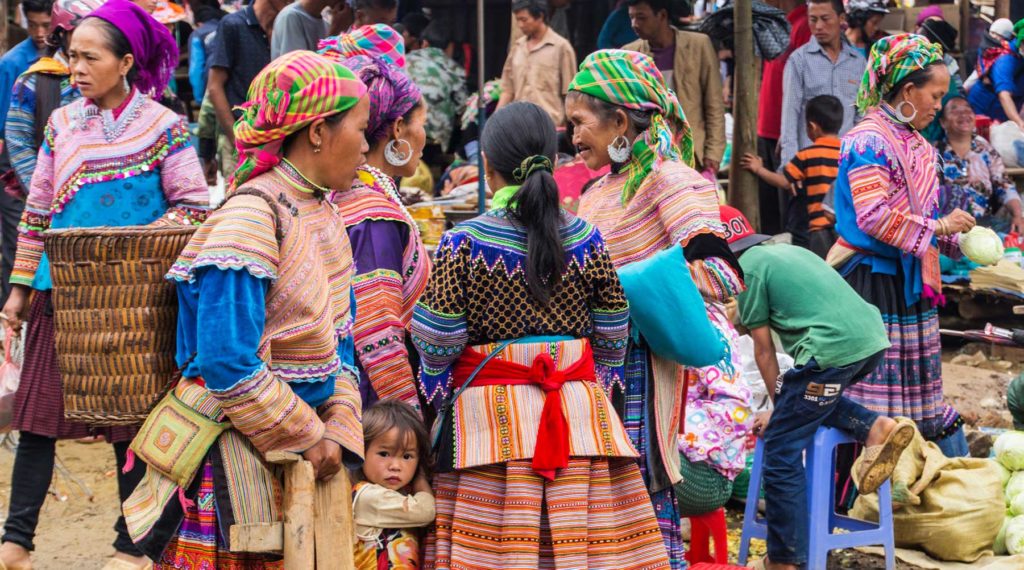About Bac Ha Market – Vietnam’s Most Colorful Ethnic Market
Bac Ha Market takes place in Bac Ha District, located in the same Lao Cai province as Sapa, about 100 kilometers to the northeast. It’s the largest and most visited ethnic minority market in northern Vietnam—and one of the most vibrant. Held only on Sundays, the market comes to life from early morning until midday.
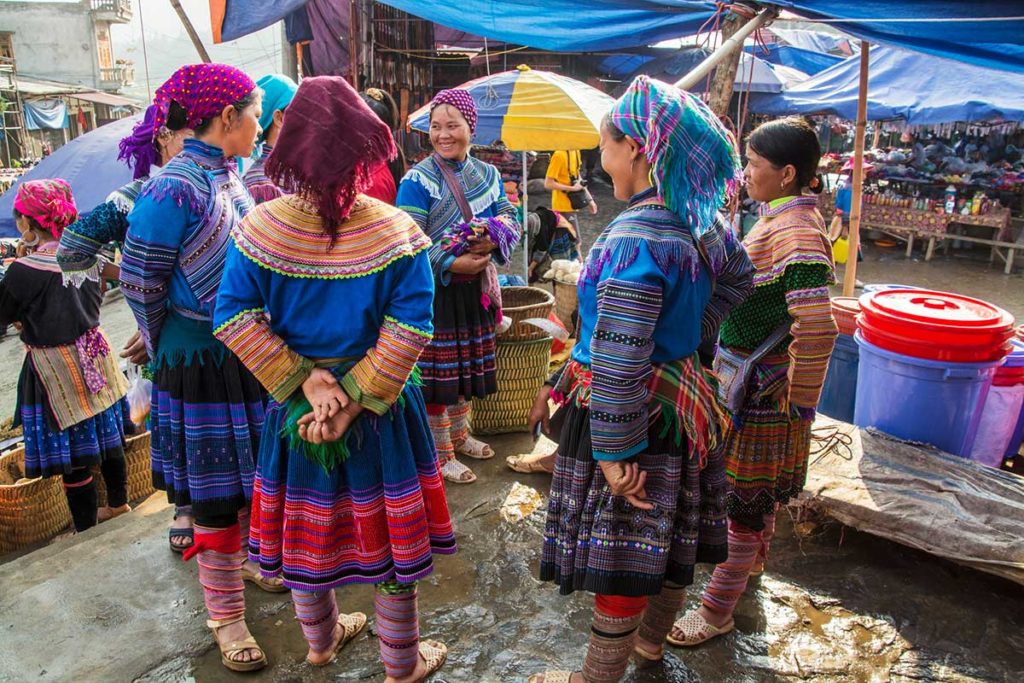
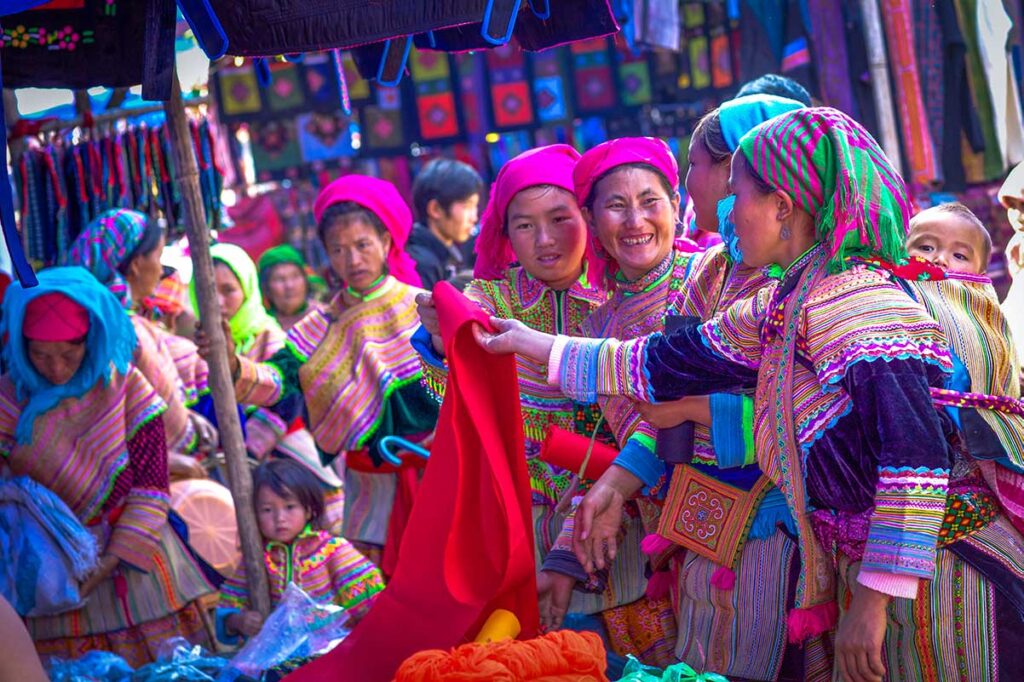
Dozens of ethnic groups, especially the Flower Hmong, travel from remote mountain villages to take part. For many, it’s more than just a shopping day. It’s a chance to socialize, exchange news, enjoy strong corn wine, strengthen family ties, and sometimes even find a future spouse. The market is as much a cultural gathering as it is a place of trade.
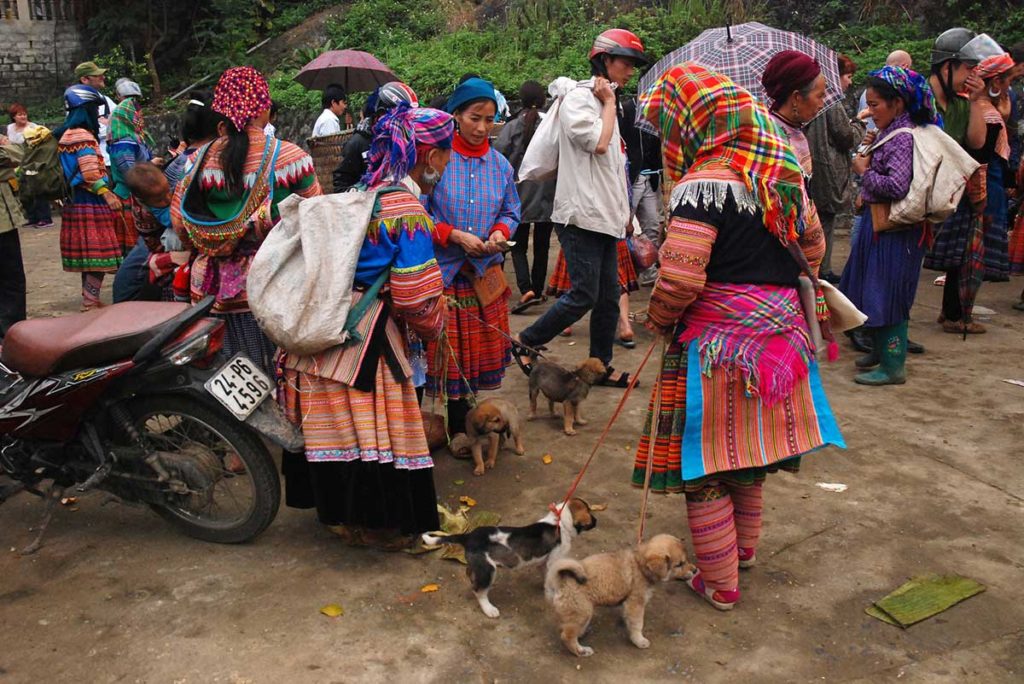
The atmosphere is loud, colorful, and chaotic in the best way—very different from the polished tourism feel of Sapa. While Bac Ha Market is the most popular choice for tourists looking for an authentic experience beyond Sapa, it still maintains its rural character. Tourism is slowly growing in the area, but with little infrastructure in place, the town retains a raw, everyday charm that many travelers appreciate.
What to expect on Bac Ha Market
Bac Ha Market is not just a place to look around—it’s a functioning rural market that serves the needs of the local community. The market is divided into zones, each focused on a different type of goods or activity. From early morning until midday, the area fills with energy as locals shop for necessities, meet friends, share food, and trade livestock. As a visitor, it’s fascinating to wander from one section to another, each with its own character, sounds, and smells.
Fresh produce & wet market
This is where locals stock up on everyday ingredients—seasonal vegetables, mountain herbs, and several types of rice, including colorful varieties popular in the region. It’s a working market, not arranged for tourists, so expect narrow lanes, loud conversations, and a flurry of buyers and sellers in motion.
The wet market section sells raw meat and fish, often laid out on tables or in trays. It’s worth a look, but be prepared for strong smells and graphic sights. If you’re curious about local food culture, this is where it all starts. It’s busiest in the early morning, especially under the covered areas.
Ethnic food court
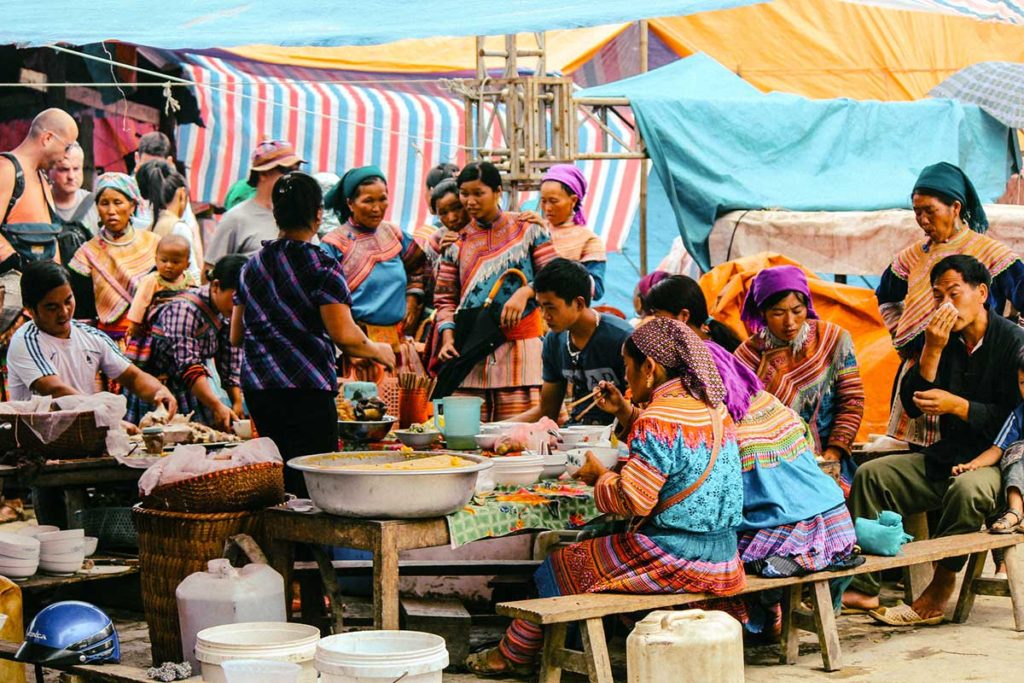
In the open-air eating area, locals gather for breakfast or a late-morning meal. Think of it as an ethnic food court—with low plastic stools, large steaming pots, and the buzz of communal dining. The most well-known dish is thắng cố, a stew traditionally made with horse or buffalo meat and organs. It’s not for everyone, but it’s a cultural staple.
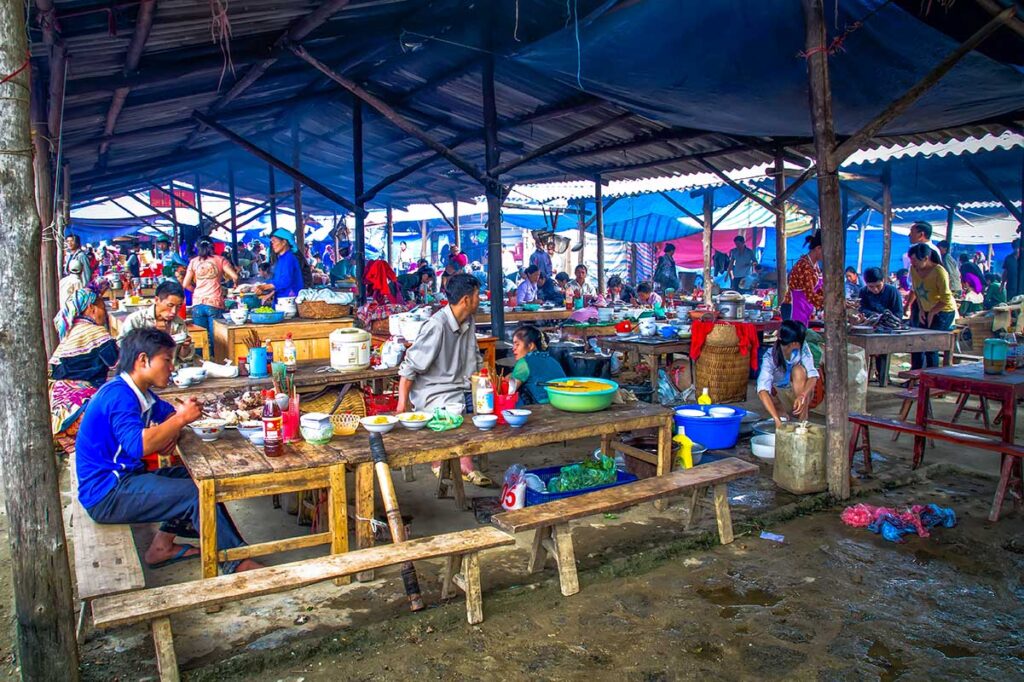
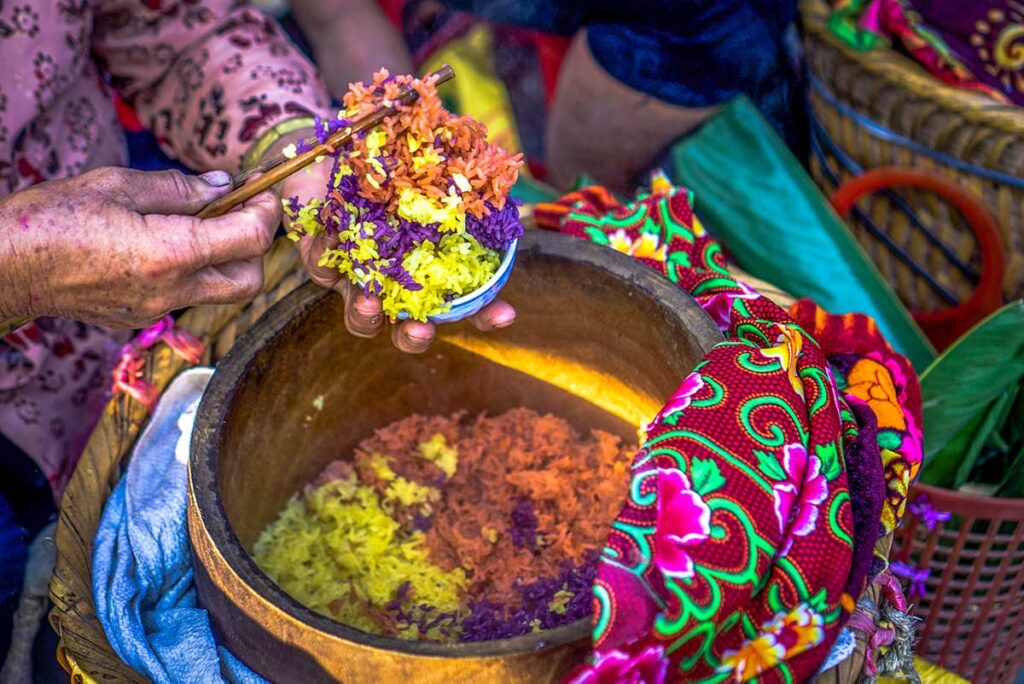
You’ll also find grilled skewers, pho-style noodle soups, and sticky rice dishes. And of course, there’s corn wine. By mid-morning, expect a lively atmosphere with plenty of noise and laughter as locals relax and socialize over a meal and a drink.
Clothes

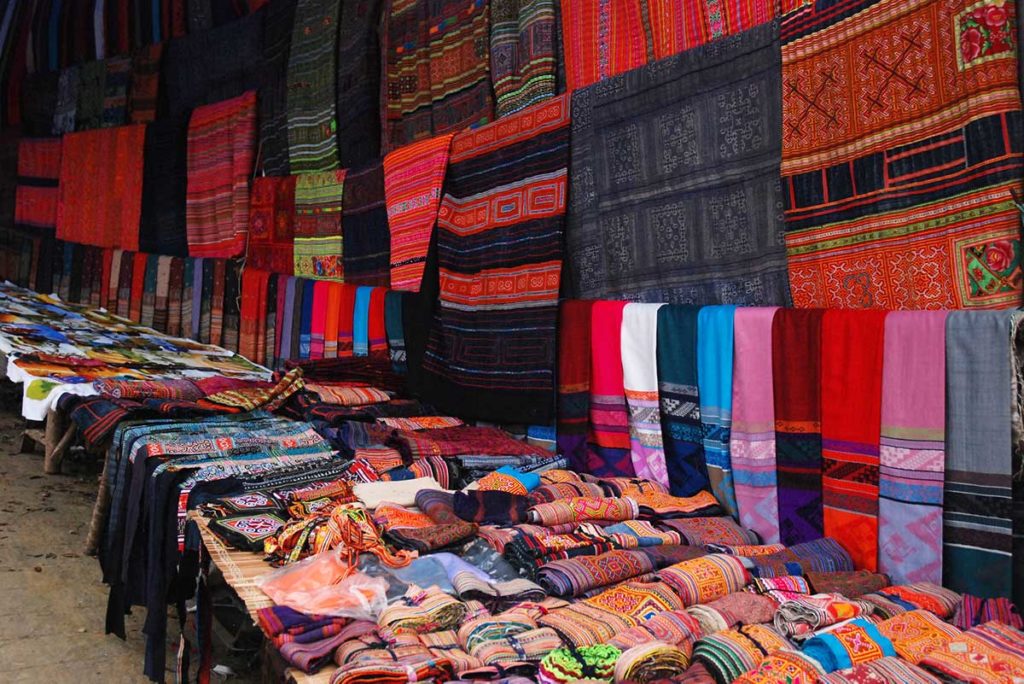
One of the most eye-catching parts of the market is the clothing and textiles section. Here, you’ll see rows of handmade traditional outfits in bright colors and detailed embroidery. Each ethnic group has its own patterns and styles—most notably the Flower Hmong, whose vibrant clothes dominate the area.
You’ll also find bags, scarves, fabrics, and decorative pieces. Sellers are usually happy to explain the meaning behind the patterns if you ask. Even if you’re not buying, it’s a visually rich part of the market that reflects the diversity of the region.
Jewelry and handicrafts
This section features handmade accessories—silver earrings, bronze bracelets, rings, and other small trinkets. Some stalls cater to tourists with items like keychains or souvenirs, while others are clearly meant for local shoppers. It’s a good place to pick up an authentic, small gift or just browse the craftsmanship.
Household goods & imports
Not all parts of the market are colorful or photogenic. This section sells what people in the area actually need—tools, cooking pots, shoes, cheap clothes, and plastic containers. Some products are imported from nearby China. It’s not especially interesting for tourists, but it offers a glimpse into daily life and what sustains the local economy.
Livestock & Animal market
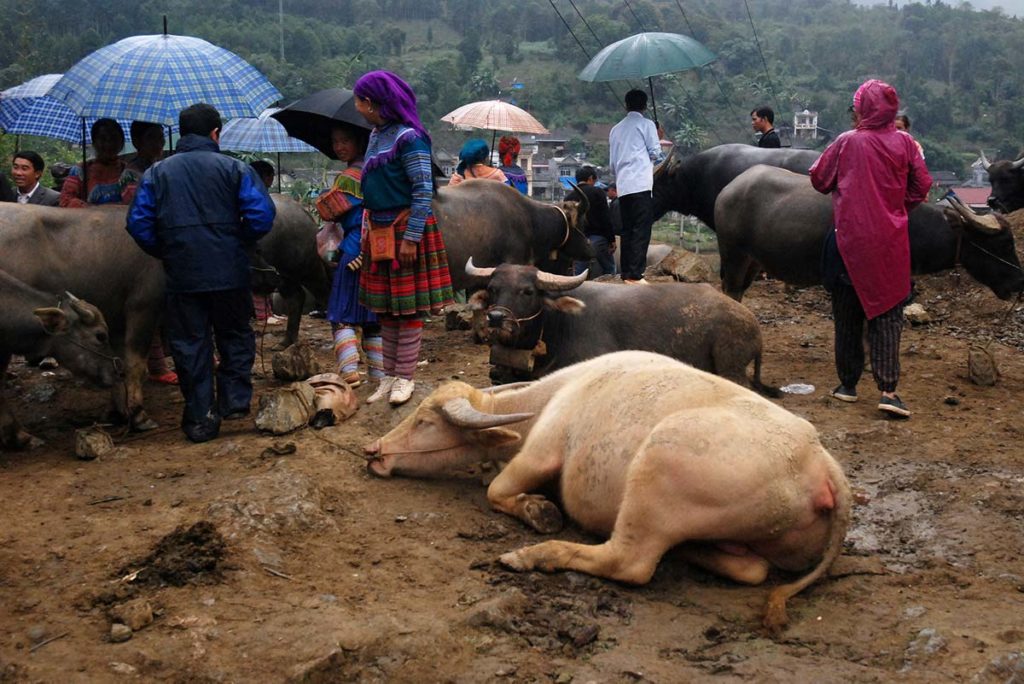
Located on a hill slightly removed from the main market, the livestock area is one of the market’s most distinctive sights. Locals come here to buy and sell pigs, chickens, buffaloes, and even horses. The horse trade is particularly unique—Bac Ha is one of the only places in Vietnam with a specialized horse market zone.
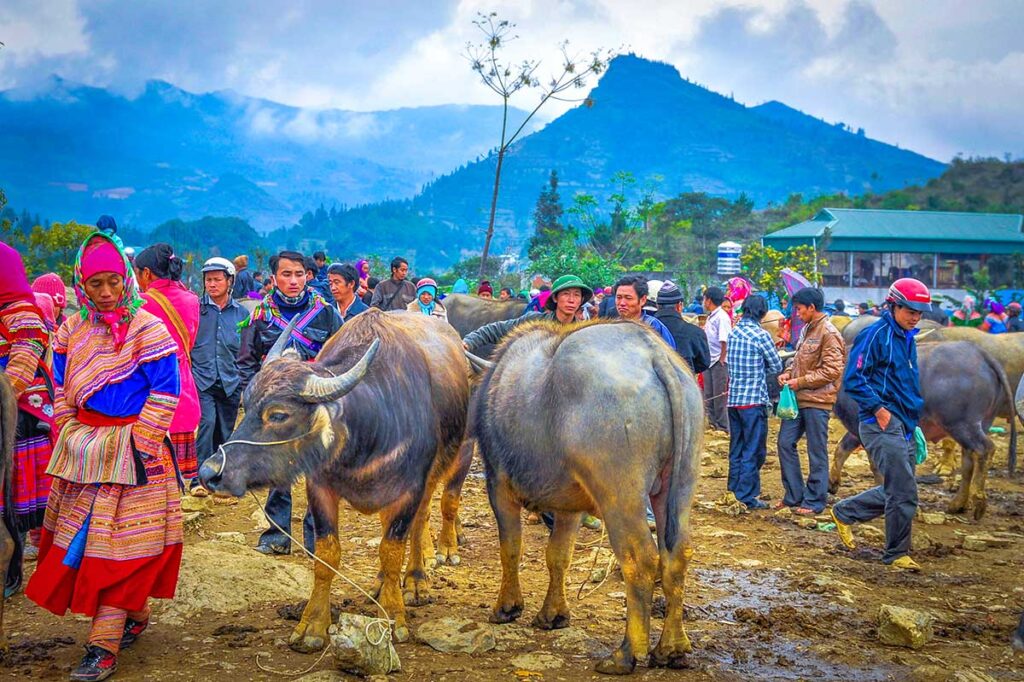
It’s chaotic, loud, and muddy. Watch where you step, and don’t expect a sanitized experience. But for visitors curious about rural life, this is one of the most genuine and memorable parts of the day.
Best time to visit Bac Ha market?
Locals from the nearby villages around Bac Ha come to Bac Ha Market just once a week, on Sundays from early morning to noon (6 am – 12 pm). Many of these young and elderly men and women of the Dao and Hmong hill tribes head to the market as early as 4 a.m. to set up their stalls and collect their items to display in an attractive manner.
There are also several festivals held in Bac Ha by the ethnic minorities, as visiting the market makes it even more special. It’s great if you can visit the Bac Ha Market during one of these festivals.
Spring is the best time to visit Bac Ha market as it is the time of the beautiful plum blossom season and the time when various festivals are held. The festival Say San and Ruoc Dat Ruoc Nuoc are consecutively from January 2 to 6 and January 15 on the lunar calendar. These festivals are important for the beginning of the new year for prosperity and good weather for a good harvest.
The Horse Racing Festival is held in early June. The last festival is the Bac Ha Temple Festival on July 7 of the lunar calendar.
Tips for visiting Bac Ha Market
Prepare for a long journey from Sapa
The road from Sapa to Bac Ha is winding and mountainous, so the journey takes time. You’ll need to leave early—especially if you want to arrive before the market gets crowded. To make the most of the day, consider combining the market visit with other nearby sights.
Consider staying overnight on Saturday
Most visitors come on a Sunday day trip, but staying the night before lets you experience the market early, before the tour groups arrive. It’s also a good option if you plan to explore nearby villages or markets like Can Cau on Saturday.
Bring cash for small purchases
Bac Ha is not a typical tourist market, but you’ll still find handmade items, textiles, or snacks that make great souvenirs—often not made for tourists, which makes them feel even more authentic. Buying directly from ethnic sellers is a simple way to support local communities. Card payments aren’t accepted, so bring enough cash for purchases and perhaps a drink or meal in town afterward.
Dress for the weather and location
Bac Ha is in the mountains, and mornings can be surprisingly cold—especially in winter. In summer, there’s more chance of rain. Since most of the market is open-air, it’s smart to bring a jacket or raincoat. Also, out of respect for local culture, dress modestly. Shorts and T-shirts are fine, but avoid overly revealing clothing.
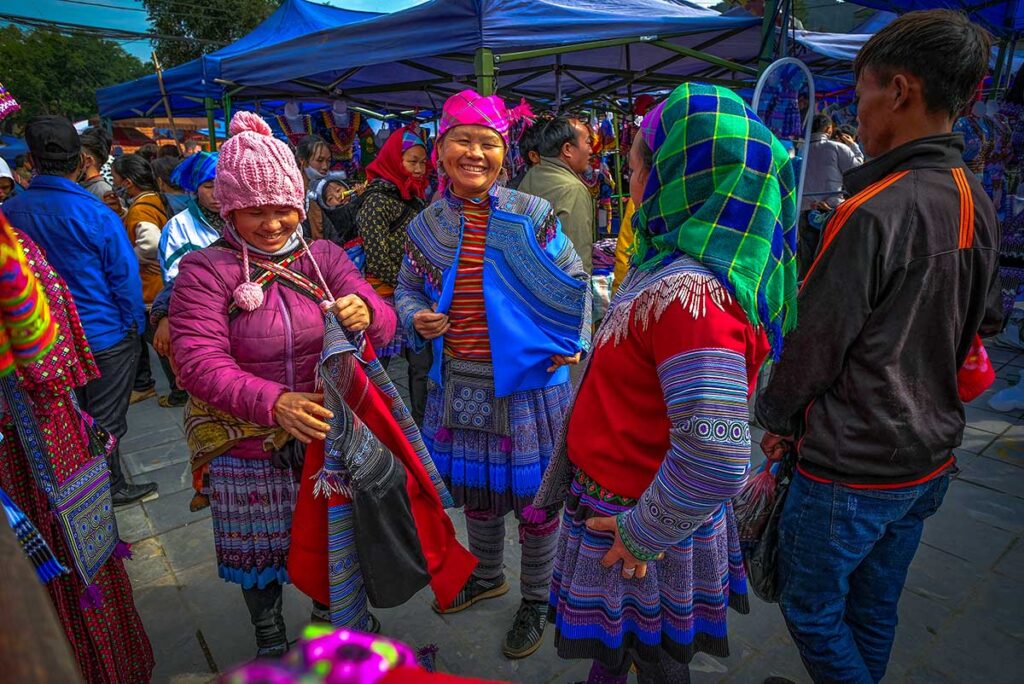
Ask permission before taking photos
Many ethnic minority people are open to being photographed, but it’s polite to ask first. A simple gesture with your camera usually works. Avoid taking close-ups without any interaction—it can feel intrusive or disrespectful.
Combine Sapa and Ha Giang via Bac Ha
If you’re planning to visit both Sapa and Ha Giang, Bac Ha makes a convenient and rewarding stop between the two. It’s possible to connect the regions by private car or motorbike, but make sure your timing lines up so you reach Bac Ha on a Sunday.
Expect a real working market, not a tourist show
Bac Ha Market is lively, crowded, and full of character. You’ll see raw meat, live animals, strong smells, and plenty of noise. It’s not polished or curated—but that’s exactly what makes it such an authentic and memorable experience.
Other things to do in Bac Ha
To make the most of your visit, it’s worth combining the market with other sights around Bac Ha. The ride from Sapa is long, so exploring more than just the market makes the trip more rewarding. Below are a few highlights you can easily add to your itinerary.
For a full travel guide to Bac Ha—including more things to do, accommodation tips, and how to get around—see our complete Bac Ha travel guide.
Hoang A Tuong Royal Hmong Palace
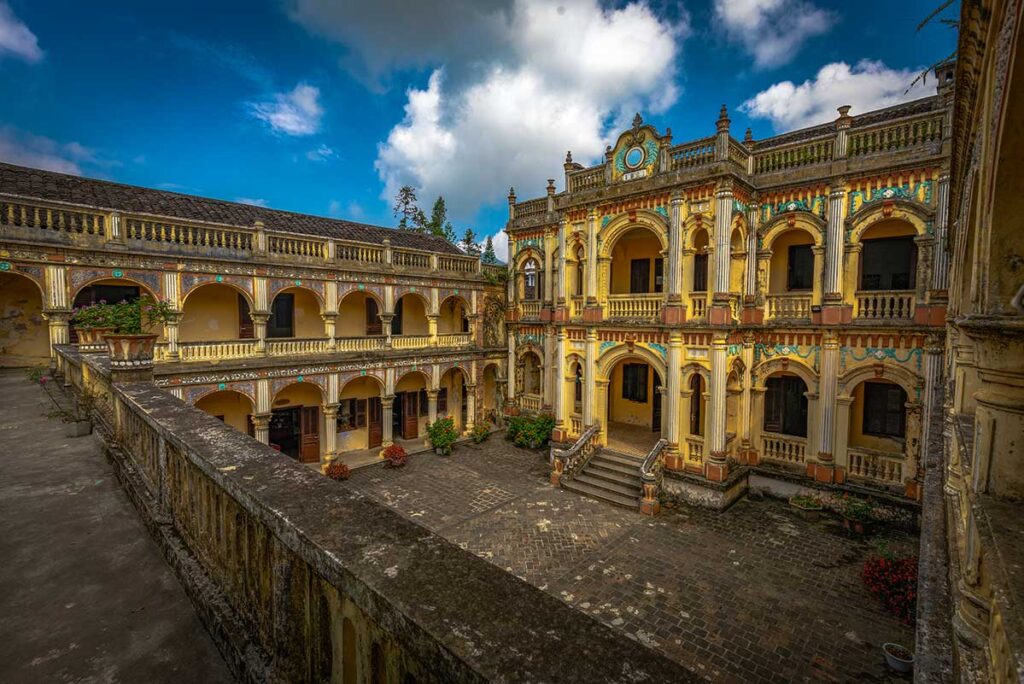
Another highlight of the city is Hoang a Tuong Palace. This used to be the most important building of the northwest region in Vietnam. Before 1945, the region around Bac Ha was ruled by the Tay ethnic minority with French colonial support. This ethnic minority had a kind of king who lived in this palace. They had a monopoly on the trade of mainly medicines, salt and food which were mainly intended for the French rulers. Today the palace is open to visitors.
Bac Ha temple
In Bac Ha you will also find a temple that is worth a short visit. It was built in the late 1800s in memory of two brothers (Vu Van Mat and Vu Van Uyen) for their honor in fighting the enemy and stabilizing the nation’s northwestern frontier. Every year on the 7th of July of the lunar calendar, there is the Bac Ha Temple Festival in commemoration.
Trekking and local villages around Bac Ha
There are some less traveled trekking and homestay tours available in the Bac Ha area for travelers who like to get off the beaten track. Trekking tours through the area will take you through rice paddies and give you a unique opportunity to visit a number of ethnic villages from the Hmong, Tay and Dzao, among others.
Thien Long Cave
More than 20 kilometers outside Bac Ha, on very winding roads, lies the Thien Long Cave. It is one of the few caves that you can visit in this part of Vietnam. It is not as special as the caves you find in other places in the country, but if you have the time you can combine it with the Bac Ha market.
How to get to Bac Ha market
Bac Ha Market is located in Lao Cai Province, the same province where Sapa is located. There are a number of options to get there from Sapa.
From Hanoi to Bac Ha
It is not difficult to reach Bac Ha from Hanoi, although this is only a small town. It takes at least 6 hours on mountainous roads. The beautiful environment through which you drive makes the journey pleasant. You can go on a tour, rent a car or minibus with a driver or drive your own motorcycle. If you go on a tour from Hanoi, you can expect to spend several days traveling around and visiting multiple destinations such as Sapa or Ha Giang, with activities such as hiking and cycling.
From Sapa to Bac Ha
Many tour operators offer tours to Bac Ha market from Sapa. There are also direct buses from the Sapa bus station. The bus from Sapa to Bac Ha takes three hours. If you are very adventurous, you can rent a motorbike or scooter and drive yourself to the market from Sapa.
Local Vietnam Sapa market tours
Local Vietnam created private tours to the Bac Ha market. If you are not on a Sunday in this region, you can also choose one of the other markets to visit. Combine a visit to a market with for example a trekking, sightseeing per car or homestay experience. You can see all our market excursions in our Sapa tours:
Hotels and homestays in Bac Hac
Most travelers visit Bac Ha as a day trip from Sapa, but staying overnight is a great way to experience the market before the day trippers arrive. It allows you to explore at a quieter pace in the early morning and catch the market at its most authentic.
Accommodation in Bac Ha is basic but perfectly fine for a night. Don’t expect the comforts or boutique hotels you’ll find in Sapa—this is a small town with mostly simple guesthouses and family-run homestays. That said, the limited development adds to the charm and makes for a more local experience.
Some recommended homestays include:
Nobita Homestay
Address: Bac Ha Town, Lao Cai Province
Cho Family Homestay
Address: Phec Bung Village, Ban Pho Ward, Bac Ha District, Lao Cai Province
Bac Ha Eco Homestay
Address: Nam Cay Village, Bac Ha District, Lao Cai Province
Other markets around Sapa
Bac Ha Market is the largest and most well-known ethnic market in the region, but it’s not the only one. Several smaller markets take place throughout the week in the surrounding districts. These markets are less visited by tourists, which means they often feel even more local and authentic. However, some are harder to reach and may require private transport or a guide.
Here are a few alternatives:
- Coc Ly Market – Bac Ha District, Tuesday
- Sin Cheng Market – Si Ma Cai District, Wednesday
- Cao Son Market – Muong Khuong District, Wednesday
- Lung Khau Nhin Market – Muong Khuong District, Thursday
- Can Cau Market – Bac Ha District, Saturday
For a full overview of all ethnic markets around Sapa and which day they take place, see our complete Sapa market guide.
Is Bac Ha Market worth a visit?
Bac Ha Market is a unique and authentic experience—still local in feel, even though it’s the most visited ethnic market around Sapa. It’s lively, colorful, and a great place for people watching, cultural encounters, and trying regional food. It’s not touristy in a staged way, and doesn’t feel overrun.
The biggest drawback is the distance. From Sapa, it’s a 2.5-hour drive each way, which can feel long for just a couple of hours at the market. That’s why it’s best to combine the trip with other activities in Bac Ha, or stay overnight to enjoy the market before the crowds arrive.
If you’re interested in ethnic culture and don’t mind the journey, Bac Ha is definitely worth the effort. It’s not the easiest place to reach—but that’s part of what makes it special.
